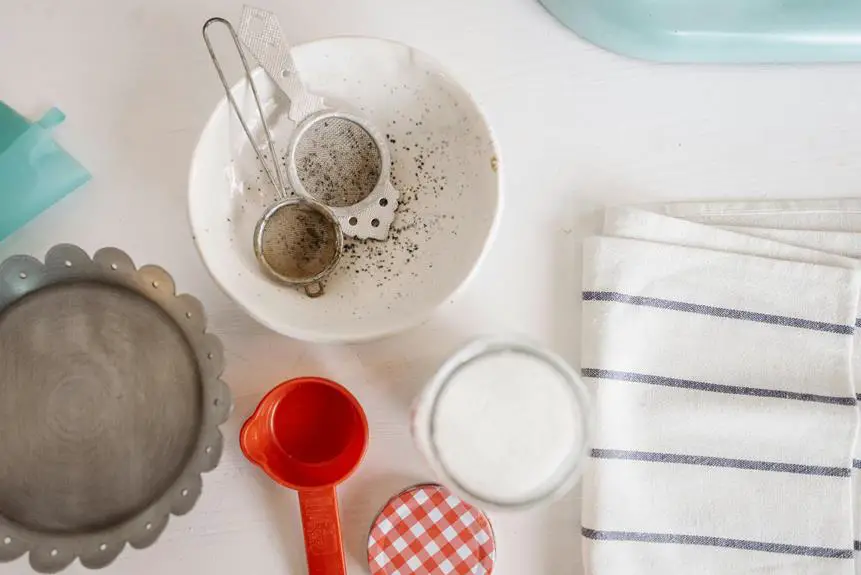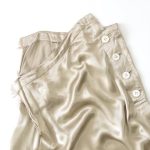When you're dealing with fraying fabric, knowing the right tools can make all the difference in your projects. You might find that fabric sealants and Fray Check products offer effective solutions, but have you considered the impact of specific sewing techniques as well? Techniques like zigzag and overlock stitches can not only stop fraying but also elevate the overall look of your work. So, what are the best options available, and how can they transform your approach to fabric management? Let's explore this further.
Table of Contents
Key Takeaways
- Fabric sealants create a protective barrier against fraying, extending the lifespan of various textiles and are often machine washable.
- Fray Check products, available in liquid, tape, and gel forms, effectively prevent fraying on intricate and heavy fabrics.
- Sewing machine techniques, like zigzag and overlock stitches, secure raw edges while enhancing the professional appearance of fabric projects.
- Hand stitching techniques, such as the whip stitch and backstitch, effectively repair and secure frayed edges, restoring fabric integrity.
Fabric Sealants
Fabric sealants are essential tools that help you prevent fraying and extend the life of your textiles. When you notice the edges of your fabric starting to unravel, applying a fabric sealant can be a quick and effective solution. These products create a protective barrier that keeps fibers from loosening and breaking apart.
Using fabric sealants is straightforward. You simply apply the sealant along the edges or seams of your fabric, and it dries clear, making it perfect for both visible and hidden areas. You'll appreciate how easy it's to use, as most sealants come in convenient applicators, allowing for precise application without mess.
One of the best features of fabric sealants is their versatility. You can use them on a variety of materials, including cotton, silk, and synthetic fibers. This means you can tackle multiple sewing projects without needing to switch products.
Moreover, fabric sealants are often machine washable, helping you maintain your textiles without compromising their integrity. Incorporating fabric sealants into your crafting routine can save you time and money in the long run by reducing the need for repairs and replacements.
Fray Check Products
When you're tackling fraying fabric, Fray Check products can be a game-changer.
You'll discover various types of Fray Check, learn how to apply them effectively, and see the benefits they bring to your projects.
Let's explore how these products can help keep your fabric looking great.
Types of Fray Check
Several types of Fray Check products are available, each designed to effectively prevent fabric edges from unraveling.
You'll find liquid options, which you can apply directly to the frayed edges. These liquids penetrate the fibers, creating a firm barrier that stops further fraying. They're great for intricate work, like lace or detailed embroidery.
Another option is Fray Check tape, which offers a quick and mess-free solution. You just cut the tape to size and press it onto the fabric edge. This method is perfect for larger projects or when you need a fast fix without waiting for drying time.
For those dealing with heavy fabrics, consider a thicker gel-based Fray Check. It provides extra support and stronger adhesion, making it ideal for denim or canvas materials. Plus, there are also fabric stabilizers that you can use in conjunction with Fray Check products to add even more durability to your seams.
Whichever type you choose, you'll find that these Fray Check products are essential tools in managing fraying fabric, keeping your projects looking polished and professional.
Application Techniques Explained
Applying Fray Check products effectively can make a significant difference in preventing fabric edges from unraveling. To ensure optimal results, follow these application techniques:
- Clean the Fabric Edge: Before applying Fray Check, trim any loose threads and clean the edge of the fabric. This helps the product adhere properly and provides a smooth finish.
- Apply Evenly: Use the applicator tip to apply Fray Check directly to the edge of the fabric. Make sure to cover the entire edge evenly, avoiding puddles or excess buildup, which can alter the fabric's texture.
- Allow to Dry Completely: After application, let the Fray Check dry thoroughly. This usually takes about 10-15 minutes but check the product instructions for specific drying times. Avoid touching or manipulating the fabric during this period to ensure a solid seal.
Benefits of Using Fray Check
Using Fray Check products can significantly enhance the durability of your fabric projects by preventing fraying and unraveling at the edges. This clear, liquid sealant works wonders on various materials, including cotton, silk, and blends. When you apply Fray Check, you're creating a protective barrier that keeps your seams intact and your fabrics looking fresh.
One of the biggest benefits you'll notice is the time saved on repairs. Instead of constantly re-sewing or patching frayed edges, you can simply apply Fray Check as a preventative measure. It's perfect for those quick fixes, too—just a dab can save you from a more extensive project down the line.
Fray Check is also easy to use. With a precise applicator tip, you can control the amount you apply, ensuring you don't overdo it. Plus, it dries clear, so it won't affect the aesthetics of your project.
Lastly, it's a cost-effective solution. A small bottle can last through numerous projects, making it a smart investment for anyone who loves crafting.
Give Fray Check a try, and see how it transforms your fabric work!
Sewing Machine Techniques
When you notice fabric starting to fray, employing specific sewing machine techniques can quickly stabilize the edges and extend the life of your projects. Here are three effective methods you can use:
- Zigzag Stitch: Use a zigzag stitch along the raw edges. This stitch allows the thread to hug the fabric, preventing further fraying while giving a decorative touch.
- Overlock Stitch: If your machine has an overlock option, utilize it to encase the edges. This technique trims the fabric as it sews, creating a clean, professional finish that significantly reduces fraying.
- Straight Stitch with a Narrow Hem: For lightweight fabrics, fold the edges inward and sew a narrow hem. This not only secures the fabric but also provides a polished look.
Bias Tape and Piping
Bias tape and piping can effectively finish raw edges and enhance the overall appearance of your sewing projects. When you apply bias tape, you're not just preventing fraying; you're also adding a pop of color or texture. You can choose contrasting colors to make a statement or match it to your fabric for a seamless look.
To use bias tape, start by folding it in half lengthwise and pressing it flat. Then, pin it along the edge of your fabric, aligning the raw edges. Sew it in place, folding the tape over the edge to cover the raw fabric. This technique gives your project a polished finish.
Piping, on the other hand, adds dimension and interest. It consists of a cord wrapped in fabric, which you can insert between two layers of fabric. To incorporate piping, sew it into your seams before joining the fabric pieces. This technique can elevate cushions, bags, or garments, making them look professionally finished.
Both bias tape and piping are versatile tools in your sewing arsenal. They not only prevent fraying but also allow you to express your creativity, resulting in beautiful, durable projects.
Overlock and Serger Machines
Overlock and serger machines are essential tools for achieving professional finishes and preventing fraying on your sewing projects. These machines work by simultaneously trimming the fabric edges while stitching, which creates a clean, durable finish. They're particularly useful for knit fabrics and lightweight materials that tend to unravel easily.
Here are three key benefits of using an overlock or serger machine:
- Speed: You'll save time since these machines can sew and finish edges in one step, allowing you to complete projects more quickly.
- Versatility: They can handle various stitch types, including rolled hems and flatlock seams, making them perfect for a range of fabrics and techniques.
- Durability: The stitches created by sergers are designed to stretch, which is vital for garments that need to withstand movement without tearing or fraying.
Incorporating an overlock or serger machine into your sewing toolkit will elevate your projects and ensure they look polished. Whether you're a novice or a seasoned sewist, these machines will enhance your efficiency and results.
Hand Stitching Methods
When it comes to managing fraying fabric, mastering hand stitching methods can make a big difference.
You'll want to explore basic techniques for repairing edges effectively, as well as some creative decorative stitching ideas.
These skills not only enhance durability but also add a personal touch to your projects.
Basic Hand Stitch Techniques
Mastering basic hand stitch techniques can help you quickly repair fraying fabric and extend the life of your favorite garments. Learning these stitches gives you the confidence to tackle minor repairs without relying on a sewing machine or professional help.
Here are three essential hand stitching techniques you should know:
- Running Stitch: This simple stitch involves passing the needle in and out of the fabric in a straight line. It's great for gathering fabric or making quick repairs.
- Backstitch: Ideal for creating strong seams, the backstitch involves stitching backward to create a continuous line. It's perfect for reinforcing seams that experience more stress.
- Whip Stitch: Use this stitch to secure the edges of fraying fabric. By stitching over the edge in a circular motion, you can neatly bind the fabric and prevent further unraveling.
With these basic hand stitch techniques, you'll be ready to tackle fraying fabric confidently. Keep a needle and thread handy, and don't shy away from practicing—each stitch will help you develop your skills!
Repairing Edges Effectively
To effectively repair the edges of fraying fabric, consider using a few hand stitching methods that will provide durability and a polished finish.
One of the simplest techniques is the whip stitch. Start by folding the frayed edge under to create a clean line. Insert your needle from the back, catching the folded edge, and then loop it over to the front, repeating this process along the entire edge. This method creates a strong seam that holds the fabric together.
Another effective method is the slip stitch, which is ideal for a nearly invisible finish. Fold the edge under, then take small stitches in the folded edge, alternating with tiny stitches in the main fabric. This keeps the stitching discreet while securing the frayed edge.
If you're dealing with thicker fabric, try a catch stitch. This involves crossing your stitches in a zigzag pattern, which not only holds the fabric securely but also allows some flexibility.
Whichever method you choose, always make sure to knot your thread securely at the beginning and end to prevent unraveling. With these techniques, you can restore the integrity of your fabric edges effectively.
Decorative Stitching Ideas
You can easily enhance your fabric projects with decorative stitching methods that add a unique touch and personality. By incorporating these hand stitching techniques, you'll not only secure those frayed edges but also elevate your overall design.
Here are three decorative stitching ideas you can try:
- Sashiko Stitching: This traditional Japanese technique uses simple running stitches to create intricate patterns. It's great for adding texture and visual interest to your fabric.
- Chain Stitch: This method creates a lovely looped effect and works beautifully for outlining shapes or adding vibrant details. It's especially effective on solid fabrics, giving them a pop of color.
- Whip Stitch: While primarily a method for joining two pieces of fabric, you can make it decorative by using contrasting thread colors. Try varying the stitch length for a more dynamic look.
Experimenting with these techniques not only helps manage fraying but also transforms your projects into stunning pieces of art. So grab your needle and thread, and let your creativity flow!
Frequently Asked Questions
What Types of Fabrics Are Most Prone to Fraying?
When you're working with fabrics, you'll find that loosely woven materials, like chiffon or tulle, and natural fibers, such as cotton and linen, tend to fray more easily than tightly woven or synthetic fabrics.
How Can I Prevent Fraying During Fabric Cutting?
To prevent fraying during fabric cutting, you should always use sharp scissors or a rotary cutter. Also, consider applying a fray check solution along the edges or using pinking shears for a clean finish.
Are There Eco-Friendly Options for Fabric Sealants?
Yes, there are eco-friendly options for fabric sealants. Look for water-based products made from natural ingredients. They're safer for the environment and can effectively prevent fraying while keeping your projects sustainable and healthy.
Can I Use Fray Prevention Methods on Knit Fabrics?
Yes, you can use fray prevention methods on knit fabrics. Just be careful with the application, as some products might affect the fabric's stretch. Always test a small area first to ensure compatibility.
How Do I Choose the Right Thread for Fraying Fabrics?
To choose the right thread for fraying fabrics, consider the fabric type and weight. Use a strong, durable thread that complements your material. Polyester threads often work well, providing flexibility and resistance against fraying.
- Tetron Fabric for Marine Applications: Durability and Use Cases - June 18, 2025
- Tetron Fabric for Outdoor Furniture: Weather Resistance and Care - June 18, 2025
- Tetron Fabric for Wall Coverings: Style and Application Tips - June 18, 2025







